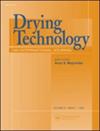Temperature control for microwave vacuum drying of raspberries
IF 2.7
3区 工程技术
Q3 ENGINEERING, CHEMICAL
引用次数: 0
Abstract
Abstract In order to optimize the microwave vacuum drying of raspberries, the temperature variation of different constant power microwave vacuum conditions was investigated. The conventional microwave vacuum drying (MVD) and the three different steady temperature control scheme was selected. A microwave intermittent vacuum drying scheme (MIVD), microwave vacuum drying power curves control scheme (MVD-T), and microwave vacuum drying power curves with intermittent control scheme (MIVD-T) were developed and conducted. As shown, temperatures under control schemes were all kept at more moderate ranges compared to constant power, where MIVD-T showed less fluctuation by adopting power curve changing with time as input variable. It was found that temperature control schemes could improve the appearance, as MVD-T and MIVD-T both reduced carbonization on the exterior and interior of raspberries. For antioxidant properties, there were differences between different schemes, in which MIVD-T could maintain more total monomeric anthocyanin (TMA) compounds and keep other antioxidant compounds similar to other drying methods. Control schemes such as MIVD, MVD-T, and MIVD-T were effective in obtaining more steady temperature materials than conventional microwave vacuum drying and were beneficial for drying quality.微波真空干燥覆盆子的温度控制
本文章由计算机程序翻译,如有差异,请以英文原文为准。
求助全文
约1分钟内获得全文
求助全文
来源期刊

Drying Technology
工程技术-工程:化工
CiteScore
7.40
自引率
15.20%
发文量
133
审稿时长
2 months
期刊介绍:
Drying Technology explores the science and technology, and the engineering aspects of drying, dewatering, and related topics.
Articles in this multi-disciplinary journal cover the following themes:
-Fundamental and applied aspects of dryers in diverse industrial sectors-
Mathematical modeling of drying and dryers-
Computer modeling of transport processes in multi-phase systems-
Material science aspects of drying-
Transport phenomena in porous media-
Design, scale-up, control and off-design analysis of dryers-
Energy, environmental, safety and techno-economic aspects-
Quality parameters in drying operations-
Pre- and post-drying operations-
Novel drying technologies.
This peer-reviewed journal provides an archival reference for scientists, engineers, and technologists in all industrial sectors and academia concerned with any aspect of thermal or nonthermal dehydration and allied operations.
 求助内容:
求助内容: 应助结果提醒方式:
应助结果提醒方式:


